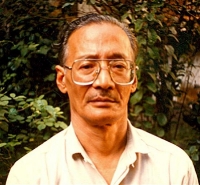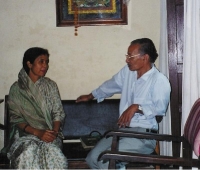I was born February 3rd, 1930 in a family of Bajracharya (Buddhist priests). My father, Durga Bajra Bajracharya, and mother Tirthakumari Bajracharya have five sons. I am the fourth one. We are members of a Bihara called “Kanaka Chaitya Mahabihar,” one of the most famous Biharas in Kathmandu Valley. Our Bihar was established about seven hundred years ago in front of the ancient Chaitya of Kanakmuni Buddha.
By caste, we are Shakya related to the Shakya of Kapilavastu, the birthplace of Lord Gautama Buddha. During the medieval period, following the principles of Bajrayana, the third advanced stage of Buddhism (following Hinayana and Mahayana), our ancestors received the consecration of Bajrayana. This consecration bestows the title of Bajracharya. To have this title, one must follow the principles of the “Heruka Chaka Samvara Tantra.” Those with the title of Bajracharya are the priests of the Newari Buddhists, one of the ancient inhabitants of Kathmandu Valley.
In 1937, I received my formal initiation as a Bajracharya, which I needed to be a member of the Bihara. In 1944, I received my consecration as Bajrayana, which I needed to be an authorized Bajracharya. In 1945, I married with Gyani Devi Bajracharya. Marriage is essential for Bajrayana practice. We have a son and four daughters.
 In addition to being priests, my family has also carried forward the tradition of Ayurvedic medicine, running unbroken from generation to generation during these seven hundred years. Our family maintains our original vows to help mankind, and especially to maintain the health of the Newari Buddhists who live around the Bihara. During all this time, we have never charged for a medical consultation. We have a very good traditional education system in our home to study Buddhism and Ayurvedic medicine side by side. We have an extensive Sanskrit family library of Ayurvedic medicines, containing many unpublished texts.
In addition to being priests, my family has also carried forward the tradition of Ayurvedic medicine, running unbroken from generation to generation during these seven hundred years. Our family maintains our original vows to help mankind, and especially to maintain the health of the Newari Buddhists who live around the Bihara. During all this time, we have never charged for a medical consultation. We have a very good traditional education system in our home to study Buddhism and Ayurvedic medicine side by side. We have an extensive Sanskrit family library of Ayurvedic medicines, containing many unpublished texts.
My grandfather, Nila Bajra Bajracharya, was a specialist in Spiritual Healing (Bhuta Vidya). In his time, he was the royal physician of Nepal. In his field, religious approaches are used to cure diseases such as paralysis, meningitis, children’s diseases and mental illness. My father was a specialist in Ayurvedic Internal Medicine (Kayachikitsa Tantra). However, he died at an early age in an accident. This tragedy actually made our family very strong. My eldest brother, Divya Bajra Bajracharya, who had already completed his studies in Internal Medicine, continued his work and study, and with the help of my grandfather, achieved a high level in Internal Medicine. He passed his knowledge to his brothers, and I am one of those who chose to specialize in the Internal Medicine field.
For six years, I studied Sanskrit from my brother and his friends. Almost all of the Buddhist and Ayurvedic texts are written in Sanskrit, so it is necessary to achieve complete fluency. During this period of study, I also had to help my grandfather and my brothers run our medical clinic. I learned the practical basics of Ayurvedic diagnosis, botany, chemistry, philosophy, anatomy, and pharmacology.
When I was seventeen years old, I finished my formal Sanskrit study. Then, I started to learn the Ayurvedic texts, including Charaka Samhita (the text of internal medicine), Susruta Samhita (surgery), Madhava Nidana (diagnosis), Madanapala Nighantu (botany and pharmacology), and Rasatarangini (chemistry). I also paid much attention to my study of Buddhism. At the beginning, I studied Naryakarana, the nine original Mahayana Buddhist texts–Pragyaparamita, Saddharma Pundarika, Lanka Valara, Dosha Bhumi, Gandavyuha, Samadhiraja, Suvarnaprabha Lahilaristara, and Guhya Samaja. I continued my study of Buddhism and Ayurveda for eight years.
During this time, with the help of my brothers, I was gaining more and more medical practice, dealing with different kinds of patients. In addition, I also had much interest to learn painting and sculpture. I practiced by drawing pictures of herbs, and making clay models of the human body. This helped me to learn anatomy in great detail, and to be able to recognize all the plants we used in our medical practice. Finally, I became free to start my individual medical practice, and to choose further advanced study.
In 1955 I realized that, first of all, I must see all the plants, and how they grow in different climates. So, I spent two years traveling on foot in Nepal and India. During this time, I collected almost all the plants that are mentioned in the Ayurvedic texts, and made color paintings of them on the spot.
After returning from my trekking, I began to treat patients without supervision. At first, I was not a success in drawing patients because I had no power to convince patients of my skill. But, in a short time, with the help of my brothers and mother, my reputation began to build. For the next fifteen years, I treated many, many Nepali patients. During this time, I decided to study English, and I began to have contact with international people. I started to study Western medical texts in detail, bringing home books each week to read, and our family now has the tradition of studying Western sciences. My son and many of the children of my brothers have attended college for this purpose. My nephew is an ophthalmologist, my son-in-law is a post-doctoral research associate in the Ohio State University School of Natural Resources, and my son Madhu Bajra Bajracharya is one of six other Ayurvedic doctors working at our clinic in Nepal.
In 1969, I started to teach Buddhism and Ayurvedic medicine to Westerners. This teaching activity made me famous in Kathmandu. In 1972 I went to Europe and America, following an invitation from one of my students, to speak at Columbia University on Buddhism. After coming back, I realized that the people of the new young generation liked very much Ayurvedic medicine. So, I opened an examining room in my family clinic, and I concentrated on handling foreign patients. This clinic is named Piyusavarsi Ausadhalaya.
In 1975 I was elected chairman of the Nepal Ayurveda Association, the nation-wide organization of Ayurvedic physicians. The main aim of the organization is to help each other for the development of Ayurvedic practice. I have written several books and pamphlets on Buddhism, Ayurvedic medicine and Nepali culture, which are published in the Nepali language. Some are translated into English, such as “Buddhist Mythology of the Kathmandu Valley.”
 I continued my work at my clinic for foreigners, and I realized very early the need for writing down all the Ayurvedic knowledge in a form which will preserve it for future generations. I also learned that the way of talking and explaining Ayurvedic Medicine to patients and foreigners required much thought and practice, and now my Western patients can understand my way of practice when I explain to them. I found out that many diseases that Western medicine cannot treat successfully can be treated with Ayurvedic medicines. I wrote a series of books and pamphlets for my Western patients. Some of the titles are “Eastern Theory of Diet,” “Hepatitis,” “An Outline of Ayurveda,” “Breast Cancer,” and “Ayurvedic Medicinal Plants and General Treatment.”
I continued my work at my clinic for foreigners, and I realized very early the need for writing down all the Ayurvedic knowledge in a form which will preserve it for future generations. I also learned that the way of talking and explaining Ayurvedic Medicine to patients and foreigners required much thought and practice, and now my Western patients can understand my way of practice when I explain to them. I found out that many diseases that Western medicine cannot treat successfully can be treated with Ayurvedic medicines. I wrote a series of books and pamphlets for my Western patients. Some of the titles are “Eastern Theory of Diet,” “Hepatitis,” “An Outline of Ayurveda,” “Breast Cancer,” and “Ayurvedic Medicinal Plants and General Treatment.”
For many decades I have maintained my practice of four hours study and writing each day, and working in the clinic for five hours in the afternoon. I have completed writing 47 books containing full descriptions of all aspects of Ayurvedic practice. The books are in the Nepali and Sanskrit languages. In 1995 I wrote “The Real Facts of Ayurveda Based on Related Ancient Science and Philosophy” in English. This book is a condensed extract briefly covering all the traditional Ayurvedic texts that I have studied. It contains short descriptions of each area.
My dream for many years has been to establish an International Ayurvedic Research Center in Kathmandu. This is becoming more important recently, because ecological destruction in Nepal is causing many of our valuable plants to disappear. Some of these plants are essential for formulas which can deal with serious diseases for which there is no medicine in other parts of the world.
To stop this destruction I am attempting to develop a model farm in Kathmandu, as part of the Institute, to teach farmers how to grow and preserve valuable plants. This will improve their incomes, and benefit the Nepali economy. As another part of the Institute, I have decided to translate my books into English so people will realize what Ayurveda really is, and the value it has for mankind. When completed, this will serve as a University level course in Ayurvedic medicine. In 1997 I completed the translation of the first of my 47 books into English, entitled “Ayurvedic Ophthalmology,” with the help of my son, Vaidya Madhu Bajra Bajracharya, my senior American student Alan Tillotson Ph.D., and American medical doctor Robert Abel, Jr. I am working very hard these days to realize my dream, and I hope to gather international support to help protect our threatened eco-systems, save our plants, bring our medicines to the world community, and, most importantly, to preserve and strengthen our traditional medicine system in Nepal.
The great Ayurvedic sage Vaidya Mana Bajra Bajracharya died suddenly in January of 2001. His clinic in Kathmandu is now in the hands of his son, Vaidya Madhu Bajra Bajracharya. He leaves behind not only his family and the Newari people, but also the tens of thousands of patients he has cured throughout the entire world. His son and senior American student decided in 2001 to begin translation of Vaidya Mana’s books into English, and in 2004 enlisted the assistance of Todd Caldecott.
0 Responses to “Autobiography of Vaidya Mana Bajra Bajracharya”